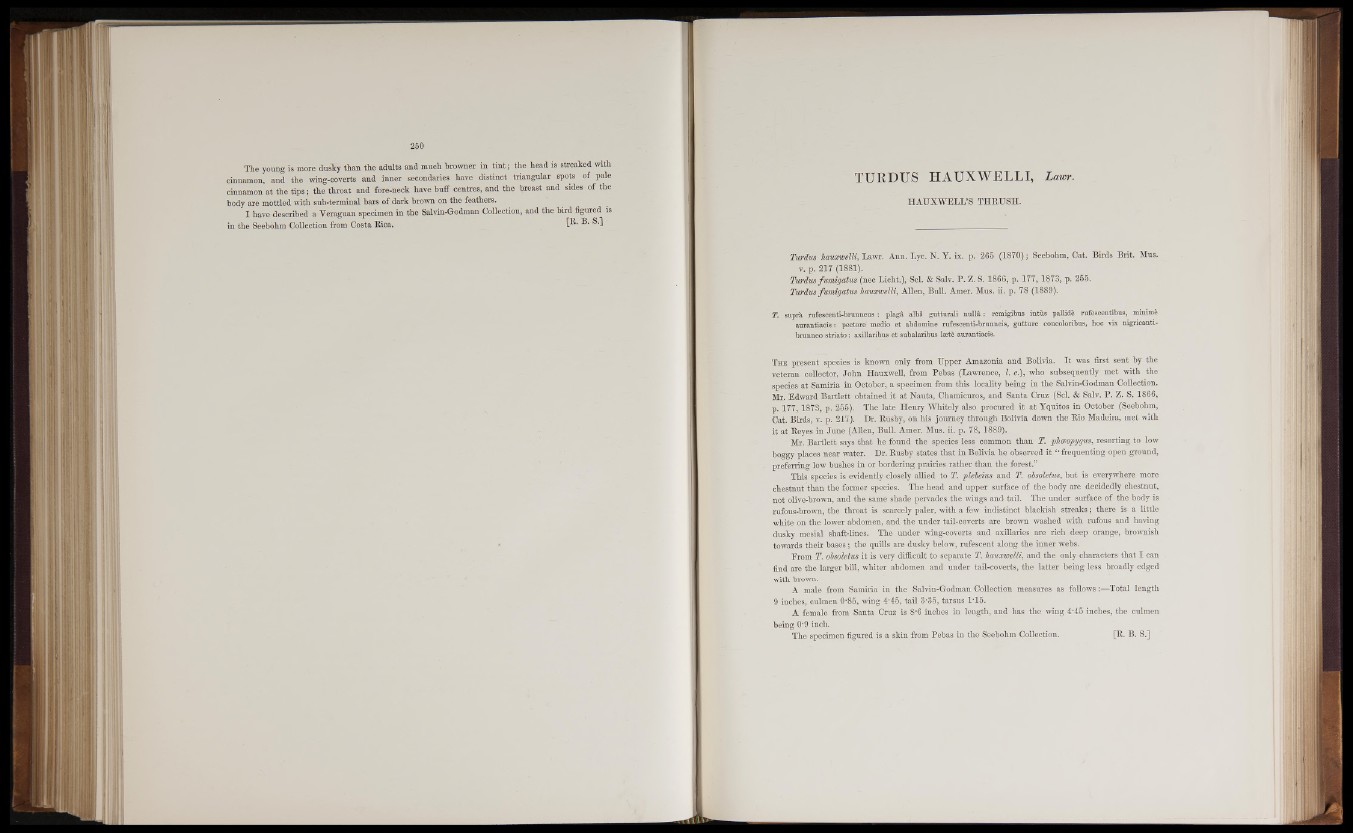
The young is more dusky than the adults and much hrowner in tin t; the head is streaked with
cinnamon,. and the wing-coverts and inner secondaries hare distinct triangular spots of pale
cinnamon at the tip s; the throat and fore-neck have buff centres, and the breast and sides of the
body are mottled with sub-terminal bars of dark brown on the feathers.
I have described a Veraguan specimen in the Salvin-Godman Collection, and the bird figured is
in the Seebbhm Collection from Costa Rica.
TURDUS HAUXWELLI, Lawr.
HAUXWELL’S THRUSH.
Twrdus hauxwetti, Lawr. Ann. Lyc. N. Y. ix. p. 265 (1870) ; Seebohm, Cat. Birds Brit. Mus.
v. p. 217 (1881).
Turdus fumigatus (nec Licht.), Sci. & Salv. P. Z. S. 1866, p. 177, 1873, p. 255.
Turdus fumigatus hauxwetti, Allen, Bull. Amer. Mus. ii. p. 78 (1889).
T. suprà rufescenti-brunneus : plaga alb A gutturali n u lli : remigibus intùs pallide rufescentibus, minimè
aurantiacis : pectore medio et abdomine rufescenti-brunneis, gutture concoloribus, hoc vix nigricanti-
brunneo striato : axillaribus et subalaribus laetè aurantiacis.
T h e present species is known only from Upper Amazonia and Bolivia. It was first sent by the
veteran collector, John Hauxwell, from Pebas (Lawrence, I. c.), who subsequently met with the
species at Samiria in October, a specimen from this locality being in the Salvin-Godman Collection.
Mr, Edward Bartlett obtained it at Nauta, Chamicuros, and Santa Cruz (Sci. & Salv. P. Z. S. 1866,
p. 177, 1873, p. 255). The late Henry Whitely also procured it at Yquitos in October (Seebohm,
Cat. Birds, v. p. 217). Dr. Busby, on his journey through Bolivia down the Bio Madeira, met with
it at Beyes in June (Allen, Bull. Amer. Mus. ii. p. 78, 1889).
Mr. Bartlett says that he found the species less common than T. phoeopygus, resorting to low
boggy places near water. Dr. Busby states that in Bolivia he observed it “ frequenting open ground,
preferring low bushes in or bordering prairies rather than the forest.”
This species is evidently closely allied to T. plebeius and T. obsoletus, but is everywhere more
chestnut than the former species. The head and upper surface of the body are decidedly chestnut,
not olive-brown, and the same shade pervades the wings and tail. The under surface of the body is
rufous-brown, the throat is scarcely paler, with a few indistinct blackish streaks ; there is a little
white on the lower abdomen, and the under tail-coverts are brown washed with rufous and having
dusky mesial shaft-lines. The under wing-coverts and axillaries are rich deep orange, brownish
towards their bases ; the quills are dusky below, rufescent along the inner webs.
From T. obsotetus it is very difficult to separate T. hauxwetti, and the only characters that I can
find are the larger bill, whiter abdomen and under tail-coverts, the latter being less broadly edged
with brown.
A male from Samiria in the Salvin-Godman Collection measures as follows :—Total length
9 inches, culmen 0*85, wing 4-45, tail 3-35, tarsus 1T5.
A female from Santa Cruz is 8-6 inches in length, and has the wing 4-45 inches, the culmen
being 0*9 inch.
The specimen figured is a skin from Pebas in the Seebohm Collection. [B. B. S.]